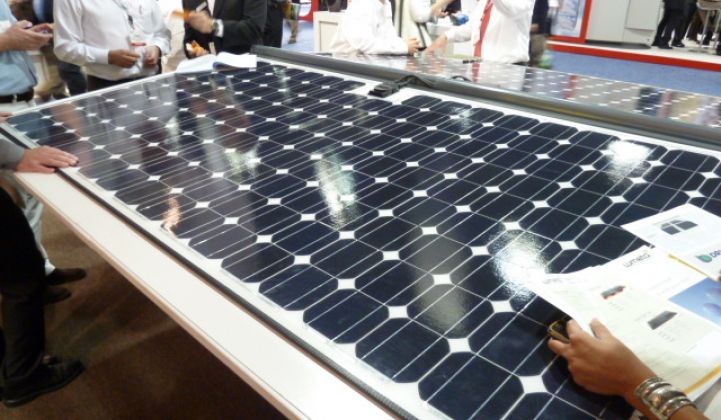Glue.
That's literally one of the secret ingredients of a new and relatively novel solar module from Lumeta that is on exhibit at Solar Power International this week.
The company, a subsidiary of a large roofing contractor called DRI Companies, has devised a 400-watt solar module that essentially sticks onto the roof of a building. You just peel off the paper on the bottom of the module, line it up on the roof in relation to the other modules, and stick it on.
"We prefer to call it adhesive," joked general manager Jonathan Pickering, the former Applied Materials exec. Either way, the panel is one of the more popular exhibits at the show. (That's a Lumeta panel stuck to a mock piece of roofing material in the picture.) In all, the panel is about two inches thick.
The idea is to curb the costs and difficulties associated with installing solar on commercial rooftops. Founder Tim Davey came up with the idea after a Fortune 100 customer of DRI's approached Davey about putting solar on its many rooftops.
"They were concerned about how to maintain the integrity of a roof after thousands of little holes" had been drilled into it to accommodate solar racks. Sticking the module to the roof eliminates the need to drill. It also generates other advantages. First, it cuts weight, an important consideration on older buildings. Lumeta's panel weighs an average of 1.8 pounds per square foot compared to 3 pounds and more for rack-mounted systems. Solar panels with ballasts to angle them toward the sun weigh five to eight pounds per square foot, according to Lumeta.
The number of components and labor involved in an install are also greatly reduced. Davey estimates that Lumeta can curb labor by 60 percent. Because it is stuck to the roof, however, Lumeta recommends getting solar panels when a company happens to need a new roof. The panels come with a 25-year warranty and membrane roofs last around 20 to 25 years, said Davey.
The 4' x 8' panels can also cover an entire roof like tiles. And, because they have virtually no wind profile, the panels won't fly off in a storm.
The "plumber's crack" dilemma in solar -- the fact that labor grows as a proportion of solar installations as the cost of solar panels declines -- has become the focus of a few startups such as Armageddon Energy (modular residential panels) and Zep Solar (minimalist racking). Over the past year, however, large solar module makers have begun to tackle the problem, as well. Suntech Power Holdings, for instance, makes utility-scale solar panels that fit into each other tongue-and-groove style. Solon and SunPower, meanwhile, unfurled megawatt-size solar power plant modules. Canadian Solar has adopted Zep's racks.
The company is currently installing its panels on a museum in Arizona but will initially largely target France and Italy. In those countries, Lumeta's panels qualify for the super feed-in tariff rates given to building-integrated photovoltaic products. Technically, Lumeta's panel isn't integrated into roofing materials, but since it gets stuck to them, both countries have given it approval. In France, the BIPV tariff is 37 euro cents compared to 28 euro cents for regular solar. (The price recently declined from 42 cents.) In Italy, the BIPV tariff is 39 euro cents versus 35.5 euro cents for normal solar.
In the States, Lumeta eventually will target schools. (Hint to Lumeta: speak to Limbach, the giant contractor from Pittsburgh that is currently conducting school retrofits.)
The panel is made from Suntech Power Holdings solar cells. The cells sit on a fiberglass substrate and are covered by a polymer rather than glass.



